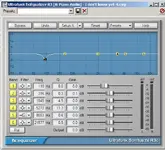R
randyfromde
New member
I just bought 2 MK-012's at the GC labor sale and have playing with them for a couple weeks now. I've been trying to record my Martin acoustic and have found a couple decent placements. My problem is that the mic placement sounds great for the entire chord progression except for when I play an open Am chord. My martin is pretty boomy as it is (as most are), but the Am chord is especially rowdy when recording.
What can I do to fix this? As I said, I really like the tone for the rest of the song, it's just 10 sec clips when the low a string is ringing that's a problem. Any suggestions? I'm using Cool Edit Pro 2.0 if that helps.
What can I do to fix this? As I said, I really like the tone for the rest of the song, it's just 10 sec clips when the low a string is ringing that's a problem. Any suggestions? I'm using Cool Edit Pro 2.0 if that helps.



